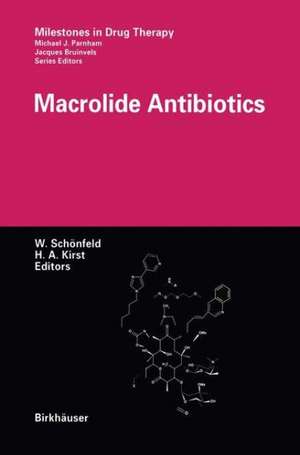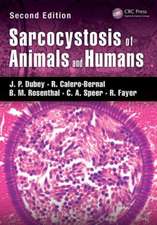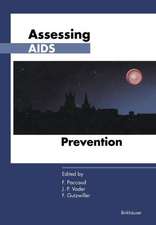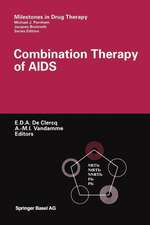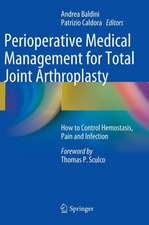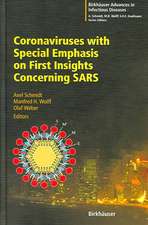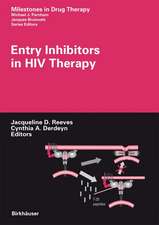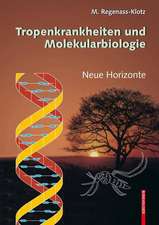Macrolide Antibiotics: Milestones in Drug Therapy
Editat de W. Schönfeld, H.A. Kirsten Limba Engleză Paperback – 23 oct 2012
| Toate formatele și edițiile | Preț | Express |
|---|---|---|
| Paperback (1) | 1096.45 lei 6-8 săpt. | |
| Birkhäuser Basel – 23 oct 2012 | 1096.45 lei 6-8 săpt. | |
| Hardback (1) | 1103.39 lei 6-8 săpt. | |
| Birkhäuser Basel – mar 2002 | 1103.39 lei 6-8 săpt. |
Din seria Milestones in Drug Therapy
- 5%
 Preț: 1409.69 lei
Preț: 1409.69 lei - 5%
 Preț: 365.46 lei
Preț: 365.46 lei - 5%
 Preț: 371.83 lei
Preț: 371.83 lei - 5%
 Preț: 711.52 lei
Preț: 711.52 lei - 5%
 Preț: 721.77 lei
Preț: 721.77 lei - 5%
 Preț: 649.11 lei
Preț: 649.11 lei - 5%
 Preț: 1103.03 lei
Preț: 1103.03 lei - 5%
 Preț: 1407.30 lei
Preț: 1407.30 lei - 5%
 Preț: 667.36 lei
Preț: 667.36 lei - 5%
 Preț: 364.53 lei
Preț: 364.53 lei - 5%
 Preț: 1093.52 lei
Preț: 1093.52 lei - 5%
 Preț: 361.06 lei
Preț: 361.06 lei - 5%
 Preț: 708.58 lei
Preț: 708.58 lei - 5%
 Preț: 365.10 lei
Preț: 365.10 lei - 5%
 Preț: 1099.35 lei
Preț: 1099.35 lei - 5%
 Preț: 1097.18 lei
Preț: 1097.18 lei - 5%
 Preț: 1284.08 lei
Preț: 1284.08 lei - 5%
 Preț: 641.46 lei
Preț: 641.46 lei - 5%
 Preț: 1100.64 lei
Preț: 1100.64 lei - 5%
 Preț: 1606.80 lei
Preț: 1606.80 lei - 5%
 Preț: 1425.76 lei
Preț: 1425.76 lei - 5%
 Preț: 671.70 lei
Preț: 671.70 lei - 5%
 Preț: 710.23 lei
Preț: 710.23 lei - 5%
 Preț: 1801.57 lei
Preț: 1801.57 lei - 5%
 Preț: 1100.30 lei
Preț: 1100.30 lei - 5%
 Preț: 1416.66 lei
Preț: 1416.66 lei - 5%
 Preț: 1092.58 lei
Preț: 1092.58 lei - 5%
 Preț: 716.65 lei
Preț: 716.65 lei - 5%
 Preț: 718.82 lei
Preț: 718.82 lei - 5%
 Preț: 715.35 lei
Preț: 715.35 lei - 5%
 Preț: 1084.72 lei
Preț: 1084.72 lei - 5%
 Preț: 1092.22 lei
Preț: 1092.22 lei - 5%
 Preț: 1092.99 lei
Preț: 1092.99 lei - 5%
 Preț: 1103.39 lei
Preț: 1103.39 lei - 5%
 Preț: 1100.85 lei
Preț: 1100.85 lei - 5%
 Preț: 1285.88 lei
Preț: 1285.88 lei
Preț: 1096.45 lei
Preț vechi: 1154.16 lei
-5% Nou
Puncte Express: 1645
Preț estimativ în valută:
209.83€ • 218.26$ • 173.23£
209.83€ • 218.26$ • 173.23£
Carte tipărită la comandă
Livrare economică 14-28 aprilie
Preluare comenzi: 021 569.72.76
Specificații
ISBN-13: 9783034894388
ISBN-10: 3034894384
Pagini: 336
Ilustrații: X, 323 p.
Dimensiuni: 155 x 235 x 18 mm
Greutate: 0.47 kg
Ediția:Softcover reprint of the original 1st ed. 2002
Editura: Birkhäuser Basel
Colecția Birkhäuser
Seria Milestones in Drug Therapy
Locul publicării:Basel, Switzerland
ISBN-10: 3034894384
Pagini: 336
Ilustrații: X, 323 p.
Dimensiuni: 155 x 235 x 18 mm
Greutate: 0.47 kg
Ediția:Softcover reprint of the original 1st ed. 2002
Editura: Birkhäuser Basel
Colecția Birkhäuser
Seria Milestones in Drug Therapy
Locul publicării:Basel, Switzerland
Public țintă
ResearchCuprins
to the macrolide antibiotics.- Macrolides: a clinical overview.- Pharmacokinetics/pharmacodynamics of macrolides.- Cellular accumulation of macrolide antibiotics. Intracellular bioactivity.- Clarithromycin and new derivatives of erythromycin.- Azithromycin and novel azalides.- Ketolides: novel antibacterial agents designed to overcome resistance to erythromycin A within gram-positive cocci.- Novel macrolide derivatives active against resistant pathogens.- Polyketide diversity.- Biosynthesis of the macrolide antibiotic, tylosin.- Activity of macrolides against mycobacteria.- Chlamydia pneumoniae and asthma and atherosclerosis: role of macrolides...- Activity of macrolides in sexually transmitted diseases.- Helicobacter pylori and macrolides.- Effects of macrolide antibiotics on ribosome function.- Mechanisms of resistance to macrolides, lincosamides, and ketolides.
Textul de pe ultima copertă
The current state of research, development, and use of macrolides as a treatment option for bacterial infections is the subject of this monograph. Macrolides, whose first representative (erythromycin) was introduced into the market in the 1950s, have been optimised by various companies into effective, safe, and convenient treatments with overwhelming success. Various compounds, such as azithromycin, clarithromycin, erythromycin, and roxithromycin, are in current effective use for treatment of infections mainly of the respiratory, gastrointestinal, and urogenital tracts and skin and soft tissues. A highly competitive research environment and critical medical need for improved macrolides have led to various new scaffolds and derivatives such as the ketolides ABT-773 and telithromycin, which are in development or in the regulatory process for market approval.
The individual chapters cover aspects of microbiology, clinical use and experience, pharmacokinetics, pharmacodynamics, biochemistry, and chemistry. They are written by leading experts in their respective fields. Thus, readers - whether they are professionals in the pharmaceutical industry, physicians treating infections, or biochemists, chemists, pharmacologists or microbiologists at hospitals, health institutes, or universities - will find a detailed and up-to-date knowledge base about current research activities and a sound, stimulating overview of the compound class.
The individual chapters cover aspects of microbiology, clinical use and experience, pharmacokinetics, pharmacodynamics, biochemistry, and chemistry. They are written by leading experts in their respective fields. Thus, readers - whether they are professionals in the pharmaceutical industry, physicians treating infections, or biochemists, chemists, pharmacologists or microbiologists at hospitals, health institutes, or universities - will find a detailed and up-to-date knowledge base about current research activities and a sound, stimulating overview of the compound class.
